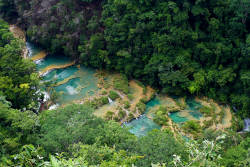Sinter Terraces
Tufa Lakes - Tufa Barriers - Travertine Terraces - Barrage Tufa


Sinter Terraces, tufa barriers, barrage tufa, also travertine terraces, are deposits of limestone in a stream or flowing body of water on the surface. The dams and pools form when the water flows down a slope with a certain gradient. At first, small deposits form on obstacles, stones or even plants, and then over time, larger and larger barriers form in the stream. Over time, these barriers develop into smaller pools that cascade the water. In rare cases, smaller pools become larger lakes, sometimes with dams several metres high. The dams keep growing because limestone is precipitated at the water surface as calcite and transported by waves to the edge, where it is deposited on the edge.
When the water is cold, dams of porous calcareous tufa form, the calcareous tufa variety is typical for karst areas with very calcareous karst springs. Branches and twigs that have fallen into the water, as well as algae, mosses and ferns that grow on the dams, are encrusted by limestone and when they have decomposed pores remain. In temperate zones, such sinter basins are usually Quaternary formations, in other words they are relatively young. Particularly strong growth spurts occurred during the interglacial periods; in some cases the temperature was higher and the yield of the springs was also greater than today. This is why the dams grew faster than they do today. In addition to the formation of dams and terraces, there was also the deposition of huge layers or deposits of tufa. Since growth is largely dependent on temperature, sinter terraces are largest and most spectacular in the tropics, even still in the subtropics. In temperate latitudes they are rather small.
At thermal springs, dams are made of travertine, densely layered calcareous sinter or sometimes even opal if the spring is very rich in quartz. The thermal water is usually too hot for plant growth, and hot water can also dissolve quartz, so this form of dam can also be made of water-rich quartz. These pools are therefore very similar to rimstone pools in caves, which is just a result of the lack of vegetation in both cases. In contrast to rimstone pools in caves, such travertine terraces form relatively quickly on the earth’s surface. The dams are usually white, but can be coloured beige, brown or reddish by iron oxides. Algae growth can also cause greenish colouring, but these are on the surface and when the algae die off the colour normally vanishes.
- Examples
 Five-Flower Lake, China
Five-Flower Lake, China Semuc Champey, Guatemala
Semuc Champey, Guatemala Badab Soort, Iran
Badab Soort, Iran Terme di Saturnia, Italy
Terme di Saturnia, Italy Kuang Si Falls
Kuang Si Falls Hierve el Agua, México
Hierve el Agua, México Agua Azul, México
Agua Azul, México Bua Tong, Thailand
Bua Tong, Thailand Erawan Falls, Thailand
Erawan Falls, Thailand Sai Yok Noi Waterfall, Thailand
Sai Yok Noi Waterfall, Thailand Sri Nakarin Dam, Thailand
Sri Nakarin Dam, Thailand Pamukkale, Turkey.
Pamukkale, Turkey. Mammoth Hot Springs, Yellowstone National Park, U.S.A.
Mammoth Hot Springs, Yellowstone National Park, U.S.A.
- See also

 Index
Index Topics
Topics Hierarchical
Hierarchical Countries
Countries Maps
Maps Search
Search